Pheidole militicida - The "Soldier Killer" Ants
An account of watching and photographing *Pheidole militicida* - the "Soldier Killer Ants"
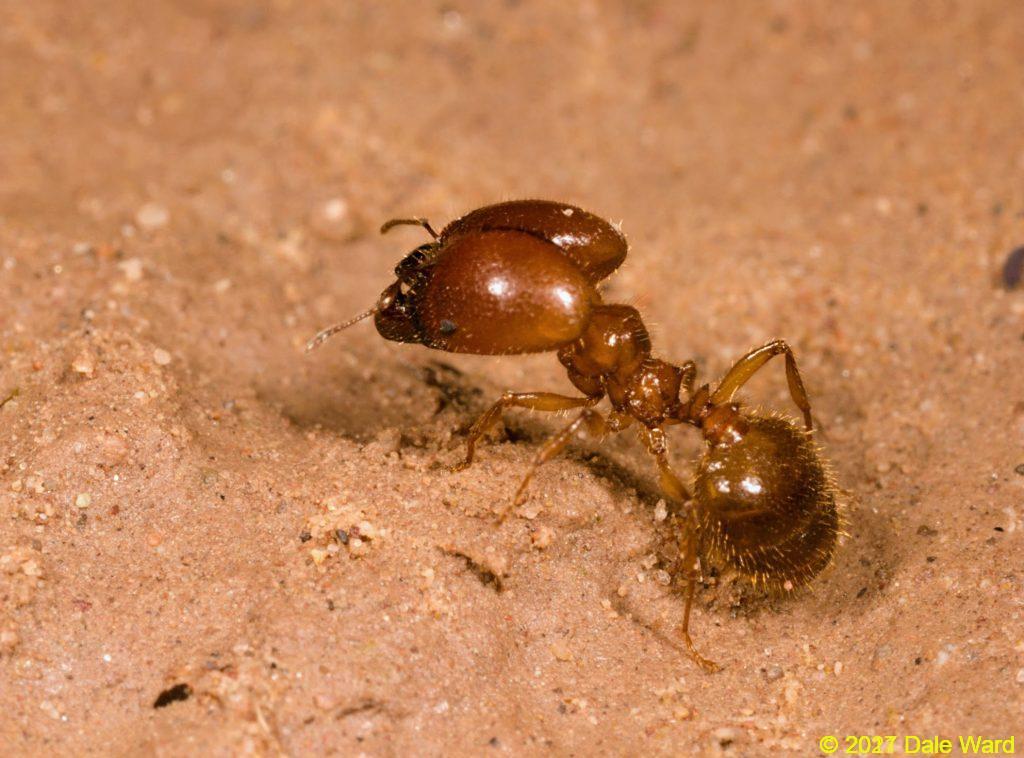 _Pheidole militicida_ major worker
_Pheidole militicida_ major worker
One of the Arizona ants that I had always wanted to see was Pheidole militicida. Like many Arizona ants, they are a seed harvesting species.
Their major caste has spectacularly over-sized heads, heads so disproportionately large that you would think the major workers would tip over.
In 1910, William Wheeler found the major workers early in the year, but then could not find any live major workers in the Fall. The only trace of the major workers that he could find were “…numerous heads and dismembered bodies…” of the major workers.
His supposition was that the large heads of the soldiers were for supplying the muscle needed to open tough seeds, and that the smaller workers had killed all of the soldiers after the year’s work of the harvest was done. That belief is where the “…militicida” part of their name comes from.
Dr. Wheeler wrote:
It appears, therefore, that all the individuals of this caste are regularly killed off by the workers on the approach of winter, probably after they have broken open all the hard seeds collected by the workers. Such a slaughter of the members of a large caste during a season when their activities are no longer required, when they would simply be a burden on the colony by consuming stored food and when fresh food cannot be collected, must have great advantages. Although I have never noticed this behavior in other species of Pheidole, I believe that a study of the harvesting species with very large-headed soldiers in the deserts of the southwest may bring other similar cases to light.
Most researchers don’t believe this “soldier killing” explanation is correct, but it was a neat, romantic origin-story for the ants.
I had never expected to actually see these ants, though. They seemed like mythical creatures to me, unicorns or griffins.
Then, in the middle of August, 2005, my friend Lloyd Davis took me out to see Pheidole militicida. It was enormously exciting.
We headed out to a mountain range near Benson, Colorado. We were well supplied with that favorite ant hunting supply, Pecan Sandies Cookies. These cookies have just the right consistency to act as ant bait, with just the right mix of fats and sugars to appeal to a large variety of ants. Plus, you can eat them if the ant hunting gets too quiet.
We drove out into the creosote flats surrounding the mountains in the early evening, spread our cookie crumbs in areas where there were foraging Pheidole minors or in likely looking spots, and waited. Soon we had trails of ants coming to the baits.
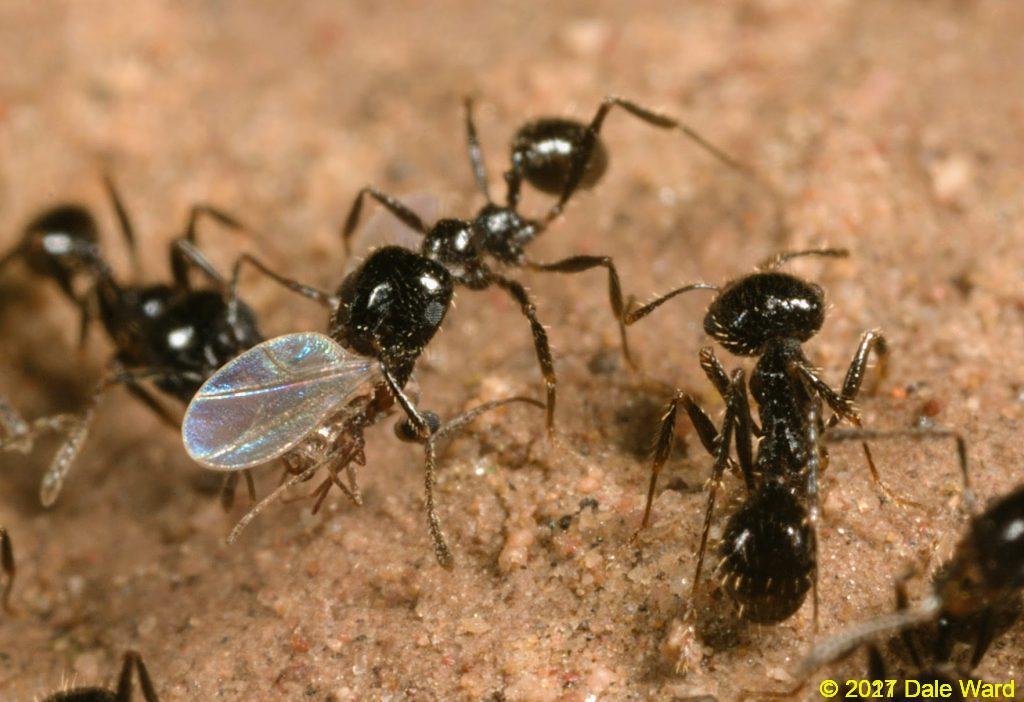 Minor worker of Pheidole militicida taking an insect back to the nest
Minor worker of Pheidole militicida taking an insect back to the nest
Lloyd said that the major workers were usually pretty shy, so we would follow the trails of the minor workers back to their nests, and put more baits there. Soon we started to see the enormous orange heads of the major workers tentatively peering out of the nests.
They were reticent to leave the nest openings. They were extremely shy. Eventually, though, the temptation of the Pecan Sandies was too much for them, and they came out to eat.
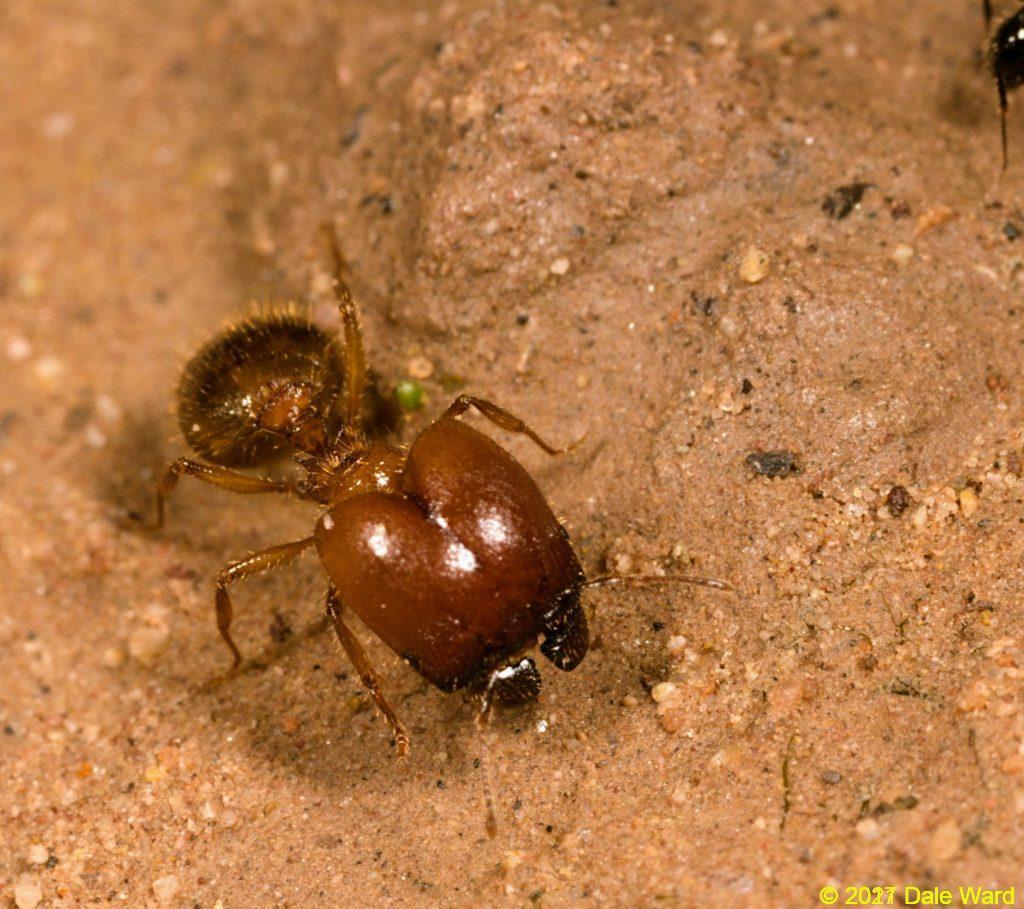 _Pheidole militicida_ major worker after tentatively coming out of the nest.
_Pheidole militicida_ major worker after tentatively coming out of the nest.
The majors moved slowly and seemed clumsy, unsure of themselves. They were absolutely enormous when juxtaposed with the minor workers.
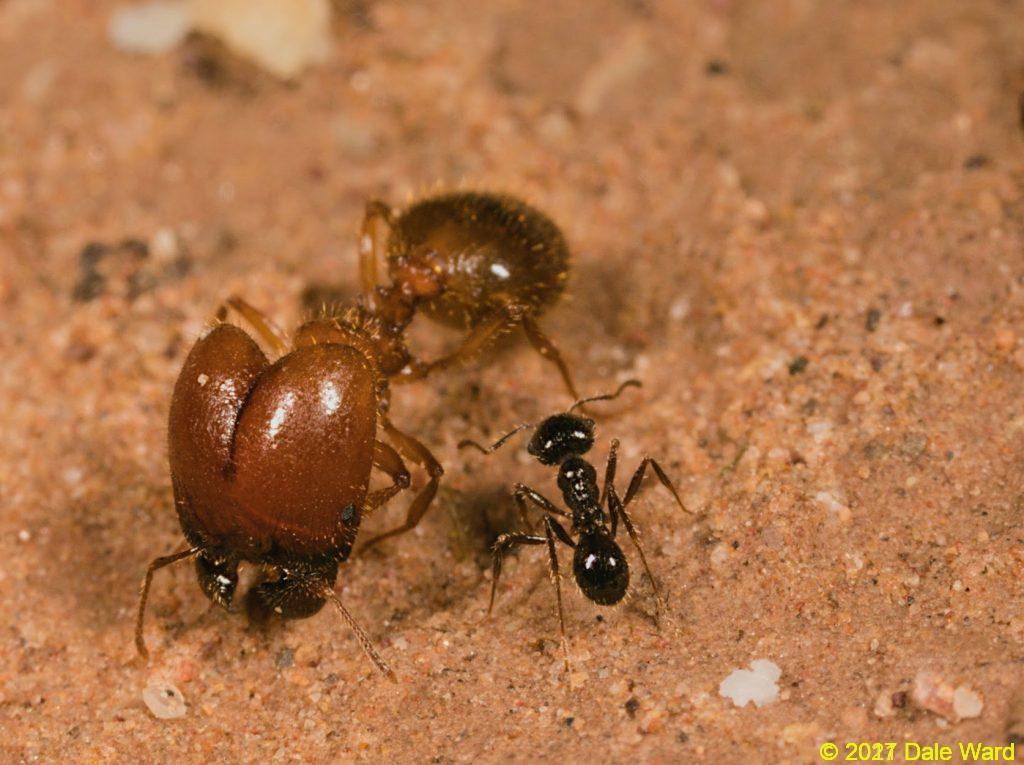 _Pheidole militicida_, major and minor workers. The major workers were enormous when compared with the minors. If I had seen them separately, I would have assumed that they were different species.
_Pheidole militicida_, major and minor workers. The major workers were enormous when compared with the minors. If I had seen them separately, I would have assumed that they were different species.
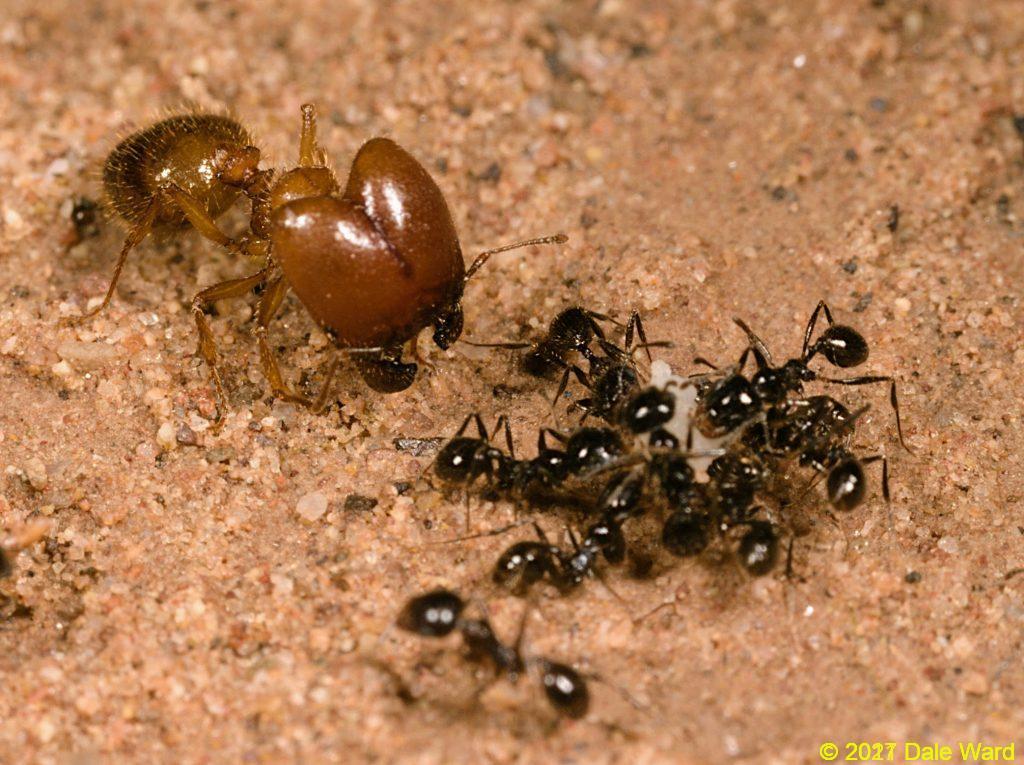 _Pheidole militicida_ Major worker with minor workers. The minors are clustered around a clump of Pecan Sandy crumbs, and the major worker wants some for herself.
_Pheidole militicida_ Major worker with minor workers. The minors are clustered around a clump of Pecan Sandy crumbs, and the major worker wants some for herself.
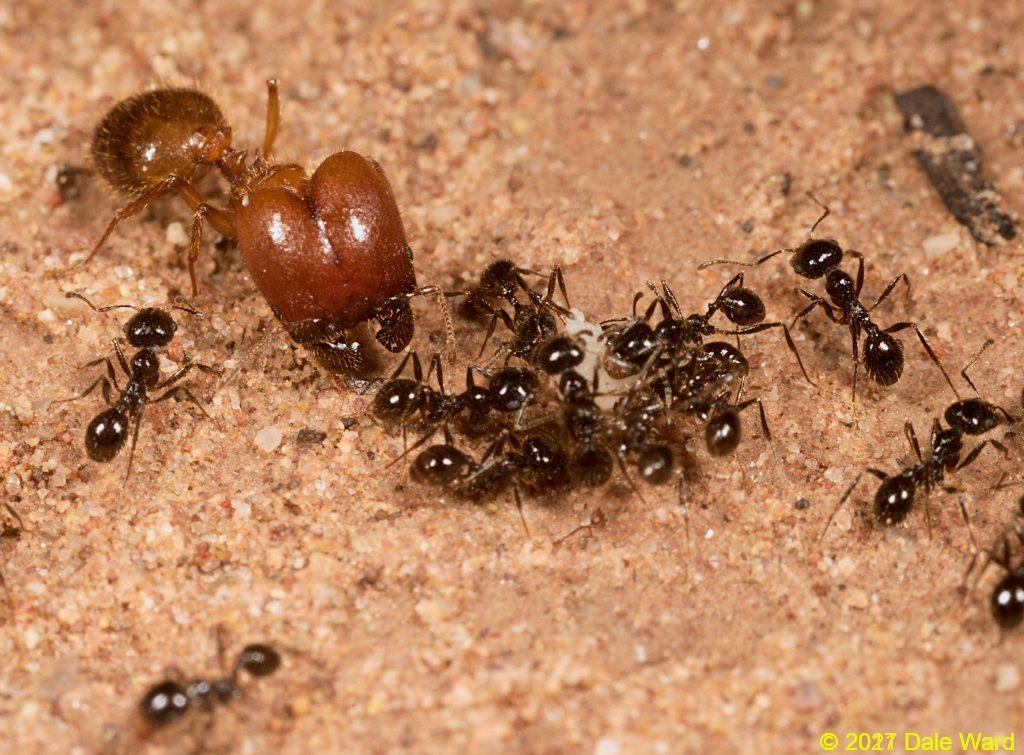 _Pheidole militicida_ Major worker with minor workers. The minor workers moved around very quickly, like “normal” ants, especially when compared with the lumbering major workers.
_Pheidole militicida_ Major worker with minor workers. The minor workers moved around very quickly, like “normal” ants, especially when compared with the lumbering major workers.
We stayed and watched the Pheidole militicida eating cookie crumbs until well into the evening. I managed to get a few photos.
What a spectacular evening it was.
When I got home, I read up some more on these cool ants. Creighton and Creighton (1959) kept colonies in the laboratory for study. They were surprised to find that the major workers did not open seeds - even the toughest of seeds were opened by the minor workers. Even in artificial nests with only major workers, the majors never even attempted to open seeds. The major workers did, however, attack workers of another seed-harvesting species, Pogonomyrmex maricopa and Pogonomyrmex californicus.
So the soldier caste in Pheidole militicida doesn’t seem to have a role in milling seeds - it really is a soldier caste, whose job is to defend the nest. The Creightons described In Dr. Creighton’s words:
It should be clear that the activities just described are considerably more methodical that the ordinary scrimmages between fighting ants. In these activities the militicida major shows an efficiency that is completely unlike its bumbling efforts elsewhere.
The Creightons speculated that the head capsules and dismembered bodies of major workers that Dr. Wheeler had found were the results of the soldiers’ fighting to defend the nest from other ants, that they were killed in the struggle.
Donald Feener (1986) went a step further than this, though. He found that Pheidole militicida workers had a special alarm pheromone that they used when they were getting raided by Solenopsis xyloni (Southern Fire Ants), and that they didn’t seem to use that ‘special’ alarm pheromone when they had conflicts with Pogonomyrmex workers.
That Feener article is, sadly, behind a paywall and I can’t read the details of it.
But imagine - Pheidole militicida knows the type of ant that is attacking it, and responds differently depending on the attacker.
What a strange world.
Sources:
Creighton, William S and Creighton, Martha P. (1959) The Habits of Pheidole Militicida Wheeler (Hymenoptera: Formicidae). Psyche: A Journal of Entomology. Volume 66.
Feener, Donald H. (1986). Alarm-recruitment behavior in Pheidole militicida (Hymenoptera: Formicidae). Ecological Entomology, Volume 11 (1) – Feb 1, 1986.
Wheeler,W.M.(1915). Article XII. — SOME ADDITIONS TO THE NORTH AMERICAN ANT-FAUNA. Bull.Amer.Mus.Nat.Hist.34 389-421.